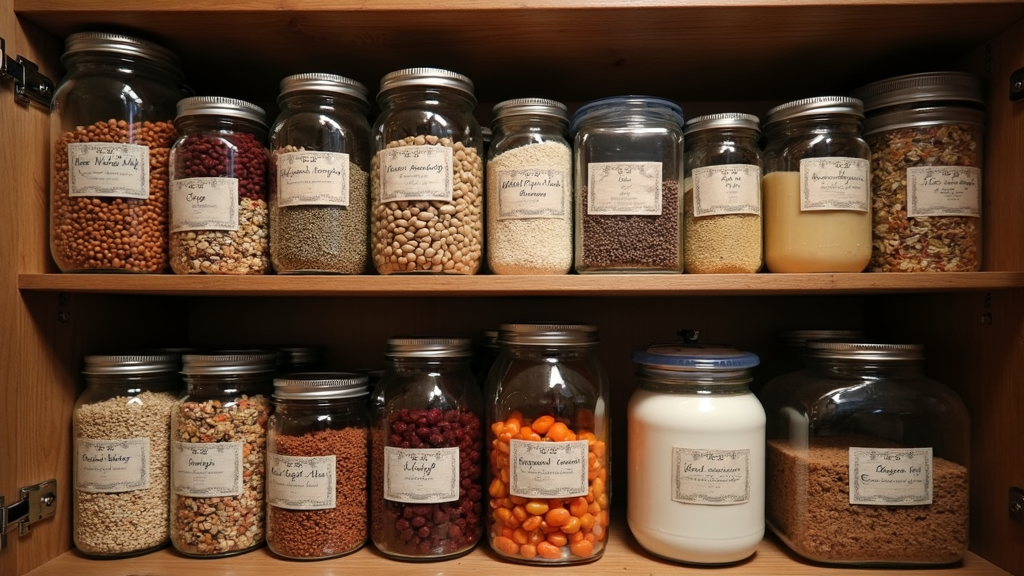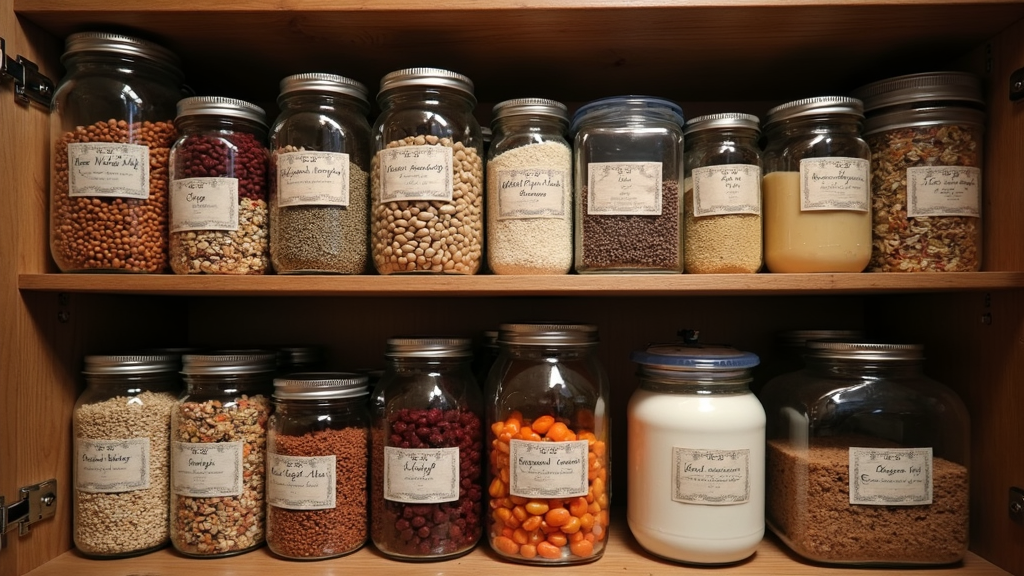Keeping your food stash both safe and nutritious is something I pay close attention to, especially if you’re storing for emergencies, prepping, or just trying to cut waste. The key isn’t just about storing food long term; it’s about making sure you actually get the nutrition you’re hoping for when you finally dig in. Here’s how I think about maintaining nutritional value in long-term stored foods, with practical tips I’ve picked up over time.

Recognizing How Nutrients Break Down in Storage
Not all nutrients in food stick around for the same amount of time. Vitamins are especially tricky, while minerals and most macronutrients tend to hold up better. If you’re new to food storage or haven’t thought about nutrient loss before, here’s what’s going on:
- Vitamin Sensitivity: Water-soluble vitamins (like vitamin C and the B vitamins) are hit hardest by air, heat, and light. These vitamins aren’t very stable, so expect some of them to disappear over months or years in storage.
- Fat-soluble Vitamins: Think vitamins A, D, E, and K. These usually last longer than water-soluble ones, but are still vulnerable if stored in hot places. Vitamins A and E are the most likely to fade away if exposed to air or heat.
- Minerals and Macronutrients: The good news is that minerals (like calcium, magnesium, and iron) stick around. Proteins, carbs, and fats do too, though fats can go rancid if exposed to air for prolonged periods.
- Enzymatic and Microbial Activity: Even shelf-stable foods can contain active enzymes. Unless you heat or blanch them before storage, these enzymes can slowly chip away at vitamins, color, and flavor.
Paying attention to these factors gives you an edge in keeping your pantry healthy, especially when you know what’s at risk and what’s more likely to last the distance.
Prepping Foods Before Storage for Best Results
Before you tuck those dried beans, veggies, or grains away, a couple of extra steps can save a lot of nutrition down the road. Here’s what I find really helps:
- Blanching Vegetables: Scalding veggies in hot water or steam for a couple minutes before freezing, dehydrating, or canning is pretty handy for keeping color, texture, and nutrients intact. I always do this before freezing homegrown crops. Even commercial frozen vegetables get this treatment to help preserve their quality.
- Acidification: When you’re canning tomatoes, jams, or pickles, adding a dash of lemon juice or vinegar cranks up the acidity. This helps preserve vitamin C and thwarts spoilage. Even a splash of acidity can go a long way for shelf-life and flavor.
- Fortification and Antioxidants: Some folks add natural antioxidants like ascorbic acid or even rosemary extract to dried or oily foods. I sometimes toss in extra B vitamins or vitamin C powder to recipes if I think they’ll be stored long-term. This can step up nutrient retention, especially for emergency stockpiles.
These small tweaks make a tangible difference by giving you a better shot at holding onto essential vitamins and minerals over months or years.
Setting up the Right Storage Conditions
Where and how you stash your long-term food makes a huge difference. I’ve learned the hard way that skipping climate control or proper packaging can be the difference between a healthy meal and disappointment. Here are my basics for the best results:
- Temperature Control: Cooler is always better. Try to keep things at 50–60 °F (10–15 °C), since this slows down all the reactions that rob food of nutrients. Every 10 °F warmer speeds up vitamin loss, so if you don’t have a basement, consider insulated boxes or a shaded area to keep food from heating up.
- Light Exclusion: Sunlight can be brutal on food. Store foods in containers you can’t see through or keep them in a dark spot; UV rays tear apart fragile vitamins like C and A, making your food lose its nutritional value faster.
- Oxygen Management: Oxygen is the main culprit behind rancid oils and faded nutrients. Vacuum-sealing, throwing in oxygen absorbers, or using nitrogen flushing works wonders for storing nuts, flours, or dried foods.
- Moisture Regulation: Low humidity (below 15%) is best for dried foods and freeze dried meals. I use desiccant packs in Mylar bags or sealed jars to stop things from clumping and keep food crisp. Even a hint of dampness can lead to mold or bacteria, so stay sharp with this.
Dialing in these elements makes a lasting difference in the quality of your stored foods, especially if you’re aiming for maximum shelf life and nutritional payoff.
Best Packaging for Preserving Nutrition
Not every container is created equal. I used to throw everything in resealable bags or basic jars, but quickly realized that better packaging saves money and vitamins in the end. Here’s what has worked for me so far:
- Barrier Materials: Multilayer pouches—especially those with foil—block out light and air far better than typical plastic bags. Mylar bags paired with oxygen absorbers are absolutely essential in my pantry for long-term storage.
- Headspace Minimization: Fill your storage jars or bags as full as you can. Less empty space means less oxygen for spoiling vitamins and fats. I try to leave just half an inch or less at the top to cut down on oxidation.
- Resealable Designs: Look for screw-topped lids or zippered Mylar bags to keep things tight once opened. Quick tip: If you open a long-term pouch, consider using a new oxygen absorber or transferring leftovers into an airtight jar for continued freshness.
Investing a bit in the right storage containers makes a noticeable difference when you pull something off the shelf a year later and find it still tastes fresh and healthy.
Comparing Food Preservation Methods by Nutrition
Each preservation method handles nutrients a little differently, so it’s worth picking what suits your needs best. Here’s a quick rundown based on my own experience and research:
- Freeze drying: Keeps over 90% of vitamins (especially C) intact for a whole year or longer. The main downside is you’ll either need pricy equipment or have to buy commercial freeze dried foods, but the results are eye-catching when it comes to nutrition and shelf life.
- Freezing: Freezer storage keeps about 80 to 90% of vitamins, especially if you blanched the food first. This works for just about anything, as long as you don’t lose power, which is the main risk in an emergency.
- Canning: Canning knocks vitamin retention down to about 60 to 80%. The heat kills off some fragile nutrients, but you can store the jars without needing electricity, making it a good option in some scenarios.
- Dehydrating: Plan on keeping 50 to 70% of vitamins in fruits and veggies you dry at home. It’s affordable, and I like it for camping snacks and lightweight meals, but some texture is lost and it needs extra care to keep from getting gummy in damp places.
- Vacuum-sealing: This doesn’t actually preserve food by itself, but it pairs perfectly with all the methods above by taking out oxygen. I use it particularly for cheese, snacks, and grains that I’ll eat within a year or so.
If you want to get into the details, Colorado State University Extension (source) shares research on how long vitamins stick around after storage.
Checking and Rotating Your Food Stash
Even with good storage, no food lasts forever. I’ve picked up a couple of habits that help make sure nothing goes to waste or loses too much nutrition:
- FIFO System (First In, First Out): Organize your pantry so the oldest stock is in front. When you add new supplies, put them at the back. It’s a simple trick that saves money and stops you from forgetting about cans or pouches for years.
- Periodic Testing: Every 6 to 12 months, pick a jar or a pouch to sample. Check for bad smells, off textures, or faded color. These are all hints that nutrients may be slipping away. If you’re really curious, consider trying a home vitamin test kit to get a sense of what’s left inside.
- Refortify When Needed: When I use really old flour or grains, I’ll add a sprinkle of B-complex or vitamin C powder during cooking. These are easy to find at most grocery stores or online, and they blend seamlessly into breads and cereals.
Sticking to these routines helps keep your food stockpile both tasty and packed with nutrients, so you’re actually getting what you need when it matters most.
Maintaining a Balanced, Nutrient-Packed Food Stockpile
Getting the nutrition right in your long-term pantry isn’t just about picking any method. It’s about matching the food to the preservation style, prepping it before stashing it away, and keeping your storage conditions just right. By slowing down damage from heat, light, oxygen, and moisture—and by staying on top of rotation and taste tests—you’ll get way more value for your health from your food stash. Stored food really can offer plenty of nutrition with the right setup, and it makes a huge difference when you need it most. Keeping sharp and making thoughtful choices as you stock up will help you create a pantry you can genuinely rely on.

